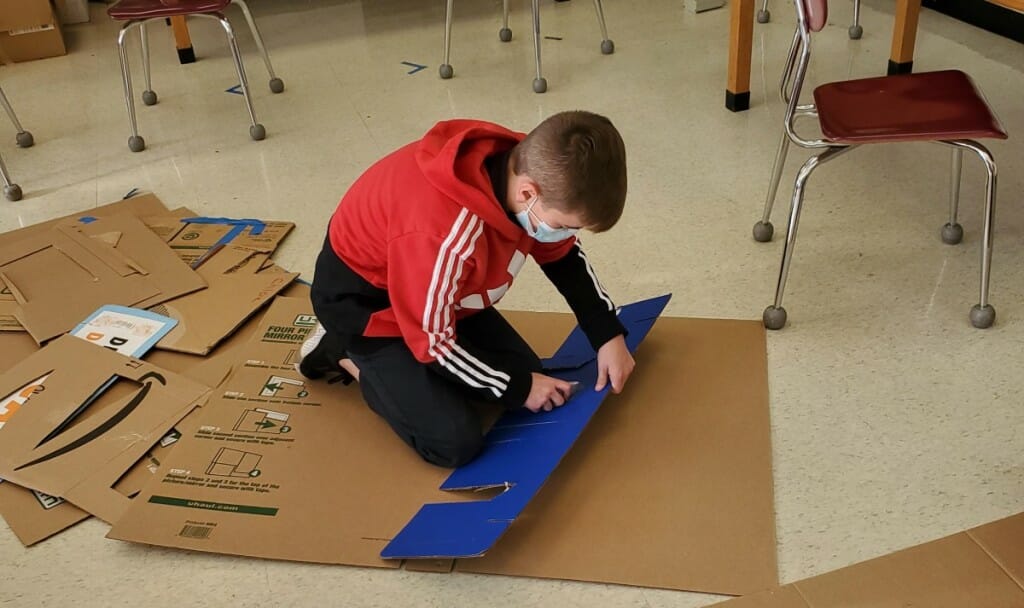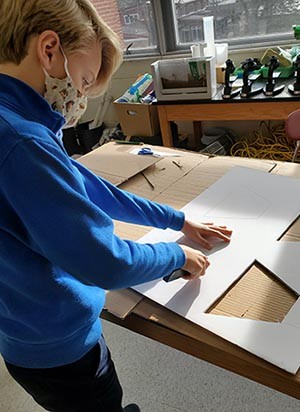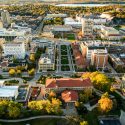2021 KidWind challenge gusts ahead as a virtual competition

6th grader John Dreher cuts out geometric shapes that he designed for wind turbine blades. The cardboard structures were then replicated and mounted on the wind turbine rotor for use in the competition. Photo courtesy of Greg Reiva
From February through June, we will highlight the ways that UW–Madison powers the state’s economy through research and innovation, educates the next generation and reaches out to Wisconsinites to improve their lives. April’s theme is Innovation. Watch for more at #CantStopABadger and #UWimpact on social media. Your support can help us continue this work.
The Quilt Blockers from Darlington, Wis. on March 6 stormed to the front of a pack of competitors from across Wisconsin and Northern Illinois to take first place in the 2021 KidWind Challenge high school division.
That same day, the St. Thomas Trojans of Crystal Lake, Ill., hoisted the middle school championship hardware.
Hosted for the fourth year by the University of Wisconsin–Madison’s Wisconsin Energy Institute – and for the first time via video conference – the competition is a hands-on design celebration that engages students through the lens of wind energy.
Teams designed and built wind turbines from scratch, measuring power output in wind tunnels designed for the occasion. An expert panel of judges then awarded points for engineering prowess and wind energy knowledge displayed during final presentations.
“I was really impressed by the level of conversation and the back and forth that they had with the judges,” says Allison Bender, Wisconsin Energy Institute outreach and events coordinator. “During these discussions, students were brainstorming about what they could try next year to level up. It shows they’re invested in KidWind for the long term.”

A student from the St. Thomas Trojans team works on a design. Photo by Greg Reiva
The “instant challenge” brought an ad-libbing spin to the contest this year, with each team creating a short commercial for a hypothetical wind farm in their community on the spot. “In other parts of the competition, students could prepare and practice knowing exactly what they’d be judged on, but the instant challenge gave teams a chance to be creative and think on their feet,” says Bender.
Competitors were also asked to include facts about wind generation and dispel wind power myths, the topic of one of the two public events of the day.
Sarah Johnston, assistant professor of agricultural and applied economics at the University of Wisconsin–Madison and a myth-busting panelist during the wind energy fact check, noted that as wind becomes a more popular and inexpensive form of energy production, wind power will inevitably become more prevalent in locales across Wisconsin.
“Learning about how this technology actually works can help communities make informed decisions about this development,” Johnston said.
Earlier in the day, students learned about another power of wind energy: jobs. Moderated by Samara Hamze, a K-12 energy education outreach specialist at UW–Stevens Point, a panel of engineers and instructors delved into pathways that could lead to wind energy careers.
“There is no single energy career. As long as a person is curious and willing to learn, there is a place for them in the rapidly expanding field of energy livelihoods,” said Hamze. “Exploring the spectrum of careers as early as middle school is important, because a student might not otherwise know that something they are good at or passionate about can be something they do for a living.”
The day culminated in the awards ceremony, giving teams a chance to come together and celebrate the accomplishment of competing in the 2021 KidWind Challenge.
“These projects give students the opportunity to implement what they have learned and to solve real problems. It also helps to solidify their interest in science and engineering well into the future,” says Greg Rieva, who coached two St. Thomas middle school teams: the winning Trojans and the runners-up St. Thomas Gold. “I am hopeful that projects like KidWind will help strengthen students’ confidence to solve problems and inspire them to pursue doing science as a career.”
Both the Quilt Blockers and the Trojans, as well as second place finishers Team Cool People from Mauston, Wis., and the Gold, earned the chance to compete in the national KidWind competition, to be held virtually in June.
The next Wisconsin Kidwind Challenge is set for March 5, 2022! Check our main event page for updates and teacher training opportunities.
Also read about the UW–Madison WiscWind team, is one of 11 teams invited to participate in the U.S. Department of Energy’s 2022 Collegiate Wind Competition.
UW-Madison contributes $20.8 billion per year to the Wisconsin economy, and UW–Madison related start-ups contribute an additional $10 billion. Read more here.



